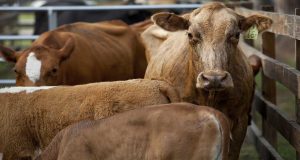US cattle markets have experienced a roller coaster ride over the last several years, with cattle prices have been supported by a declining US beef cow herd and strong beef demand. But a turning point in the US cattle industry occurred at the beginning of 2015. This 7-page fact sheet witten by Chris Prevatt and published by the UF Department of Food and Resource Economics includes highlights of the US cattle market’s cycle since 2004 and the estimated outlook for 2016, a brief analysis of the supply situation, food and forage conditions, demand and trade, competing meats, and the 2016 beef price outlook.
http://edis.ifas.ufl.edu/fe987
Tag: Beef Industry
Factors that Affect Calf Selling Price at Marketing (AN278)
 There are differences between the real and perceived reasons that cattle buyers discount calves; cattle producers can control some reasons for price differentials, but they cannot control all of them. This 4-page fact sheet will review some of the attributes that affect market calf price and overall value. Written by Matt Hersom and Todd Thrift, and published by the UF Department of Animal Science, May 2012.
There are differences between the real and perceived reasons that cattle buyers discount calves; cattle producers can control some reasons for price differentials, but they cannot control all of them. This 4-page fact sheet will review some of the attributes that affect market calf price and overall value. Written by Matt Hersom and Todd Thrift, and published by the UF Department of Animal Science, May 2012.
http://edis.ifas.ufl.edu/an278
The Impact of Production Technologies Used in the Beef Cattle Industry (AN272)
 The use of technologies in the beef industry is a major contributor to the safe, wholesome, and affordable beef supply in the United States. This 4-page fact sheet provides a brief evaluation of the effects that individual technologies have on beef production. Written by Matt Hersom, Todd Thrift, and Joel Yelich , and published by the UF Department of Animal Science, September 2011.
The use of technologies in the beef industry is a major contributor to the safe, wholesome, and affordable beef supply in the United States. This 4-page fact sheet provides a brief evaluation of the effects that individual technologies have on beef production. Written by Matt Hersom, Todd Thrift, and Joel Yelich , and published by the UF Department of Animal Science, September 2011.
http://edis.ifas.ufl.edu/an272
